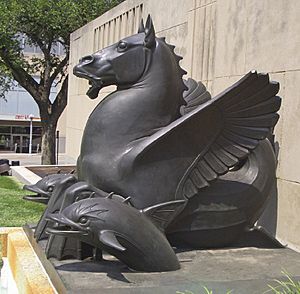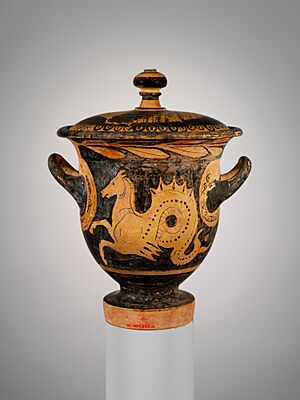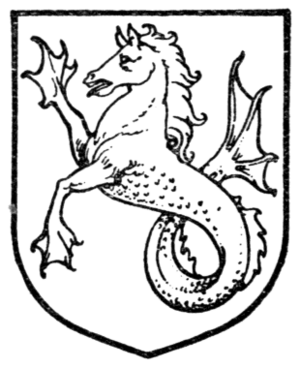Hippocampus (mythology) facts for kids
The hippocampus (say: hip-oh-CAMP-us) is a creature from old myths. It's often called a sea-horse in English. This amazing animal has the top half of a horse and the bottom half of a fish. Its name comes from ancient Greek words: "hippos" meaning "horse" and "kampos" meaning "sea monster." You can find stories about the hippocampus in myths from Phoenicia, Etruria, the Picts, Rome, and Greek mythology.
Contents
Mythology of the Hippocampus
Ancient people believed in the hippocampus. They even put its image on coins!
- Around 400 BC, coins from a city called Tyre showed their god Melqart riding a winged hippocampus. Dolphins were swimming nearby.
- Coins from another city, Byblos, showed a hippocampus diving under a ship.
- Archaeologists found a gold sea-horse from the kingdom of Lydia (in what is now Asia minor) that is about 2,600 years old.
Greek and Roman Stories
In ancient Greece, the god of the sea, Poseidon, was often linked to horses. The writer Homer described Poseidon riding in a chariot pulled by horses with bronze hooves over the sea. Later, in Roman myths, Poseidon (called Neptune by the Romans) was often shown driving a sea-chariot pulled by hippocampi.
You can still see hippocampi with Neptune today! For example, the famous 18th-century Trevi Fountain in Rome has statues of Neptune and hippocampi.
It might seem strange that sea creatures like hippocampi appeared in places with fresh water, like Roman public baths. But ancient Greeks and Romans believed that sea water flowed underground through huge caves and then came up as fresh springs. So, it made sense to them that sea creatures could be found in these places. That's why hippocampi were often used to decorate mosaics in Roman baths, like those in Aquae Sulis (modern-day Bath) in Britain.
Etruscan Beliefs
The Etruscans were an ancient people who lived in Italy before the Romans. Hippocampi appeared in their art very early on. You can see them in Etruscan tomb paintings and carvings. Sometimes, these hippocampi even had wings! Some historians think that the Etruscans believed the hippocampus helped guide souls on a sea journey to the afterlife.
Pictish Carvings
In Scotland, the ancient Picts carved sea-horses onto their famous stone monuments. The meaning of these carvings, sometimes called the "Pictish Beast" or "Kelpie", is still a mystery. It's not clear if the Picts got the idea from the Romans or if it was part of their own older myths.
Modern Uses
The mythical hippocampus is still used today in many ways:
- Heraldry: Since the Renaissance, the hippocampus has been used on coats of arms, especially for families or places connected to the sea. In heraldry, the mythical sea-horse usually has the head and neck of a horse, the tail of a fish, and webbed front feet. Sometimes, it even has wings! For example, the actor Sean Connery had winged sea-horses with horns on his coat of arms.
- Art: The sea-horse is a common image in art from the Renaissance and Baroque periods, like the Trevi Fountain in Rome (built in 1732).
- Symbols:
* Air France, a French airline, has used a winged hippocampus as its symbol since 1933. You can see it on the engines of their planes. * In Dublin, Ireland, bronze hippocampi decorate lampposts near a statue of Henry Grattan and on Grattan Bridge. * The English football team Newcastle United has two hippocampi on its team badge. They also decorate the top of the central tower at the Civic Centre in Newcastle-upon-Tyne.
Other Mythical Sea Animals
The hippocampus isn't the only creature that's part animal and part fish!
- Sea Goat: The "sea goat" is a mythical animal with the front half of a goat and the back half of a fish. This creature is represented by Capricorn in astrology.
- Other Hybrids: While not as common in Greek art, the Etruscans imagined other fish-tailed animals. These included:
* Leokampoi (fish-tailed lions) * Taurokampoi (fish-tailed bulls) * Pardalokampoi (fish-tailed leopards)
Astronomy
In 2019, a small moon orbiting the planet Neptune was named Hippocamp. It was discovered in 2013.
See also
 In Spanish: Hipocampo (mitología) para niños
In Spanish: Hipocampo (mitología) para niños
- List of fictional horses
- List of hybrid creatures in mythology
- Capricorn (astrology)
- Sea goat
- Kelpie
- Unicorn
- Water horse
- Sea horse





